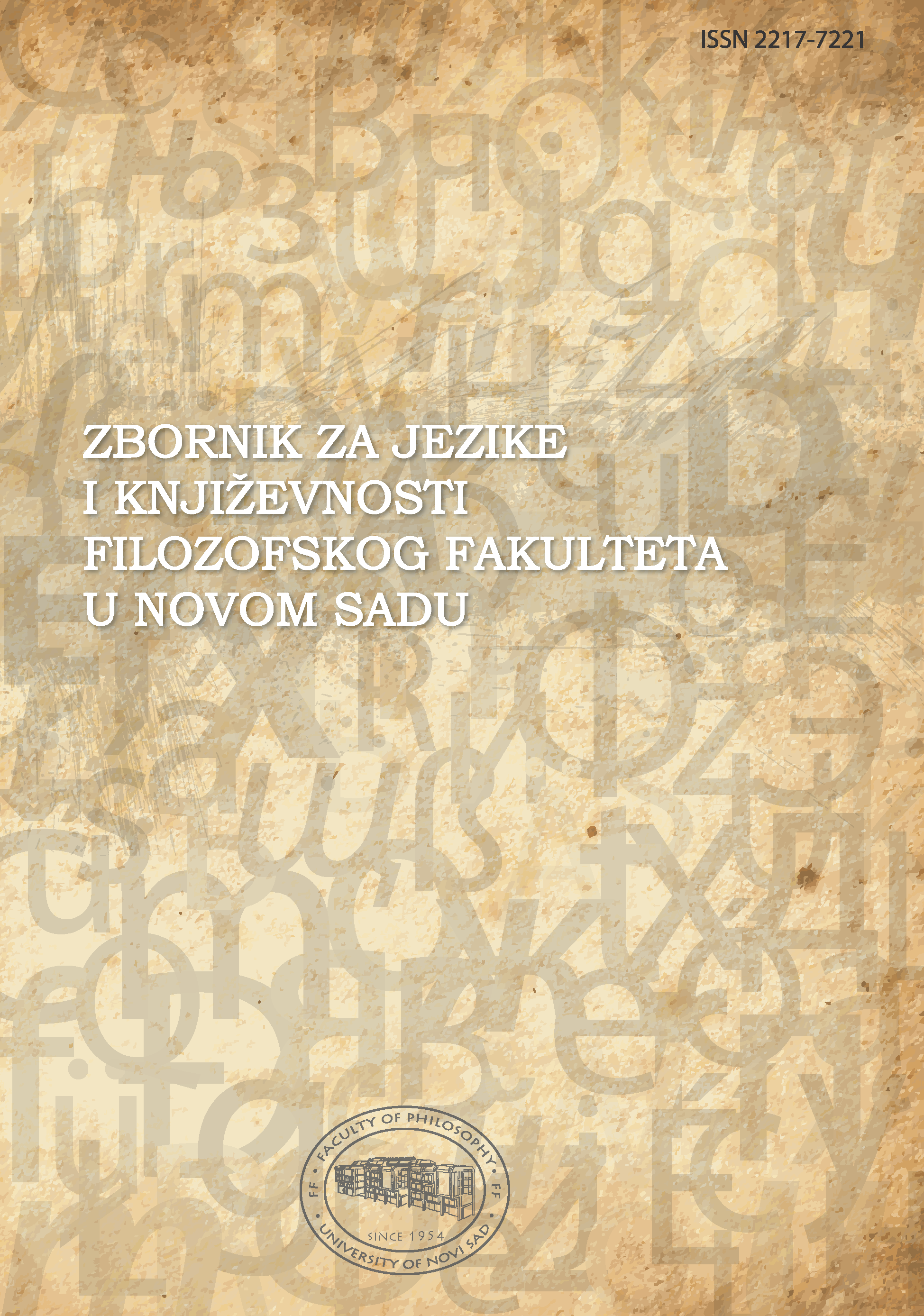SLIKOVNE SHEME U POSLOVICAMA KOJE SADRŽE SOMATIZME U ENGLESKOM I SRPSKOM JEZIKU: IZ KOGNITIVNOLINGVISTIČKE PERSPEKTIVE
Apstrakt
Predmet istraživanja u ovom radu su slikovne sheme SADRŽATELJ, SILA, RAVNOTEŽA, CENTAR–PERIFERIJA, GORE–DOLE, i PREDMET (Johnson 1987: 126) u poslovicama koje sadrže somatizme u engleskom i srpskom jeziku poput, Place one’s head in the lion’s mouth / Staviti glavu na kocku. U istraživanju je korišćen korpus sačinjen od 30 poslovica engleskog i istog broja poslovica srpskog jezika. Cilj istraživanja jeste da se definišu metaforički pojmovni obrasci kojima je motivisana upotreba somatizama u posmatranim poslovicama, kao i da se predstave slikovne sheme kroz princip utelovljenja kao univerzalne kategorije. Kognitivnolingvističkom analizom pojmovnih obrazaca stiče se uvid u stepen sličnosti načina na koji govornici engleskog i srpskog jezika konceptualizuju apstraktne pojmove polazeći od delova ljudskog tela kao izvornih domena.
Reference
Barcelona, Antonio. 2002. “Guidelines for the application of the theories of metaphor and metonymy to textual examples”. Theoria et Historia Scientiarum, Vol. VI, N° 1 Ed. Nicolas Copernicus University.
Cvetanović, Katarina. 2017. Меtaforički i metonimijski obrasci u srpskim i engleskim idiomima sa nazivima delova tela. Novi Sad: Filozofski fakultet (diplomski rad pod mentorstvom doc. dr Ane Halas Popović).
Deignan, Alice. 2005. “A Corpus Linguistic Perspective on the relationship between Metonymy and Metaphor.” Style 39(1): pp. 72–91.
Živadinović, Jovana. 2016. Pojmovna metafora u idiomima sa nazivima delova tela u engleskom i srpskom jeziku. Novi Sad: Filozofski fakultet (diplomski rad pod menstorstvom prof. dr Sabine Halupke Rešetar).
Hampe, Beate. ed. in cooperation with Joseph E. Grady. 2005. From perception to meaning: image schemas in cognitive linguistics. Berlin: Mouton de Gruyter.
Johnson, Mark. 1987. The Body in the Mind. The Bodily Basis of Meaning, Imagination, and Reason. Chicago: Chicago University Press.
Johnson, Mark. 2005. “The philosophical significance of image schemas.” In: Hampe, B. (ed.), From perception to meaning: Image schemas in cognitive linguistics. Mouton de Gruyter, Berlin/New York: 15–33. 11
Klikovac, Duška. 2004. Metafore u mišljenju i jeziku. Beograd: Biblioteka XX vek.
Kövecses, Zoltán. 2002. Metaphor. A Practical Introduction. Oxford: Oxford University Press.
Kövecses, Zoltán. 2005. Metaphor in Culture: Universality and Variation. Cambridge, New York: Cambridge University Press.
Lakoff, George. & Johnson, Mark. 1980. Mefaphors we live by. Chicago and London: University of Chicago Press.
Lakoff, George. & Turner, Mike. 1989. More than Cool Reason. Chicago: The University of Chicago Press.
Niemeier, Susanne. 2008. “To be in control: kind-hearted and cool-headed. The head-heart dichotomy in English.” In: Sharifian, F., R. Dirven, N. Yu and S. Niemeier (eds.), Culture, Body, and Language: Conceptualizations of Internal Body Organs across Cultures and Languages, Mouton de Gruyter, Berlin: 349–372.
Prćić, Tvrtko. 2008. Semantika i pragmatika reči. 2., dopunjeno izdanje. Novi Sad: Zmaj.
Prodanović-Stankić, Diana. 2008. Životinje u poslovicama na engleskom i srpskom jeziku. Beograd: Zadužbina Andrejević.
Prodanović-Stankić, Diana. 2009. “Pojmovna metonimija i metafora u značenjima lekseme srce u srpskom jeziku”. Godišnjak Filozofskog fakulteta, Novi Sad, 34, 1, 77–87.
Radić-Bojanić, Biljana. & Silaški, Nadežda. 2012a. “Head as a Container in English and Serbian – A Cognitive Linguistic Perspective“. The Journal for Languages and Literatures of the Faculty of Philosophy in Novi Sad. Volume II, pp. 65–78.
Radić-Bojanić, Biljana. & Silaški, Nadežda. 2012b. “Metaphoric and Metonymic Conceptualizations of the Head – A Dictionary-Based Contrastive Analysis of English and Serbian”. Linguistics and Literature Vol. 10, No 1, pp. 29–39.
Silaški, Nadežda, & Radić-Bojanić, Biljana. 2014. “Metonymy in expressions pertaining to hand / ruka in English and Serbian”. In: Z. Đergović-Joksimović & S. HalupkaRešetar (eds.) English Studies Today: Prospects and Perspectives (pp. 29–37). Novi Sad: Faculty of Philosophy, University of Novi Sad.
Skok, Petar. 1971. Etimologijski rječnik hrvatskoga ili srpskoga jezika. Zagreb: Jugoslavenska akademija znanosti i umjetnosti.
Szwedek, Aleksander. 2000. “The ontology of metaphors: the sense of touch in language formation.” Scripta Periodica 4, 193–200.
Szwedek, Aleksander. 2002. “Objectification: From Object Perception To Metaphor Creation.” Cognitive Linguistics To-day. Eds. B. Lewandowska-Tomaszczyk and K. Turewicz. Frankfurt am Main: Peter Lang. 159–175.
Szwedek, Aleksander. 2009. “Conceptualization of space and time.” Language, Science and Culture. Eds. P. Łobacz, P. Nowak, and W. Zabrocki. Poznań: Wydawnictwo Naukowe UAM. 317–333.
Szwedek, Aleksander. 2011. “The ultimate source domain.” Review of Cognitive Linguistics 9: 2, 341–366.
Szwedek, Aleksander. 2014. “The nature of domains and the relationships between them in metaphorization.” Review of Cognitive Linguistics 12: 2, 342–374.
Yu, Ning. 2009. From Body to Meaning in Culture. Amsterdam/Philadelphia: John Benjamins Publishing Company.
Szwedek, Aleksander. 2017. “The Object Schema”. URL:https://www.researchgate.net/publication/312371970_The_OBJECT_image_schema (29.12.2018)
George Lakoff, George. 1994. Master Metaphor List (MML). University of California, Berkeley. URL:http://www.lang.osaka-u.ac.jp/~sugimoto/MasterMetaphorList/metaphors (28.8.2018)




